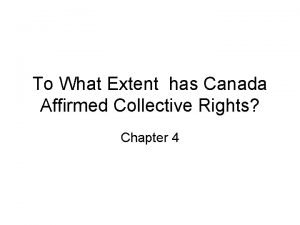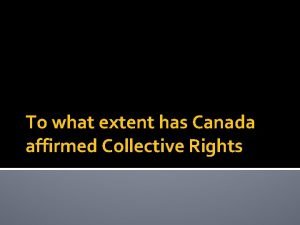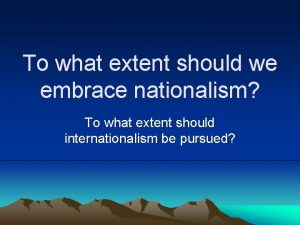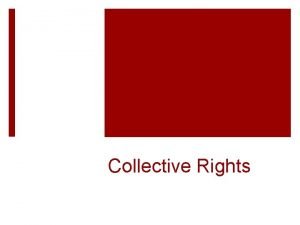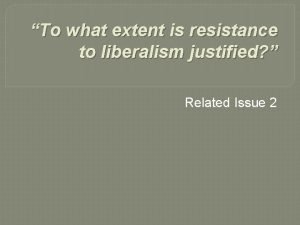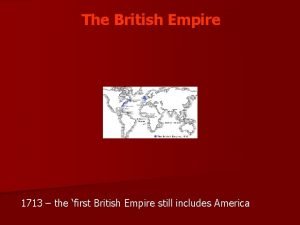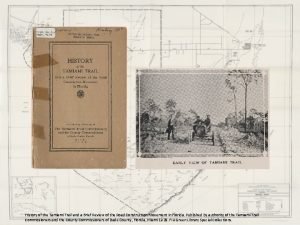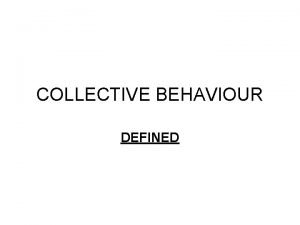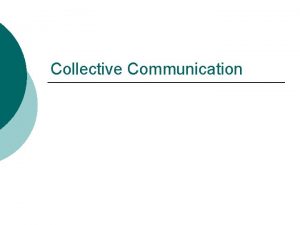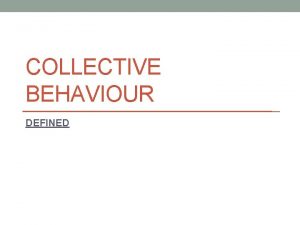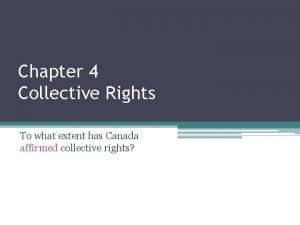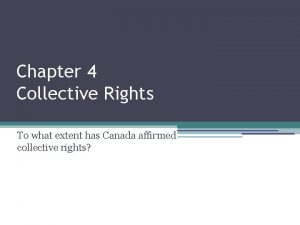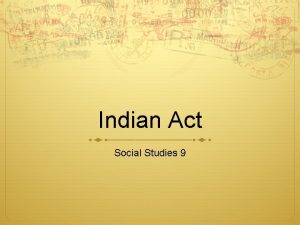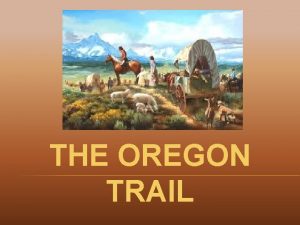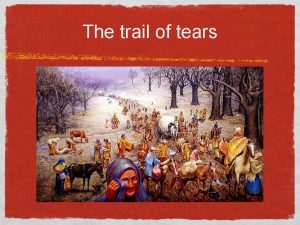Collective Rights Stoney Trail TO WHAT EXTENT SHOULD






































- Slides: 38

Collective Rights

Stoney Trail

TO WHAT EXTENT SHOULD CANADIANS SUPPORT THE RIGHTS PRESENT IN THE CANADIAN CHARTER OF RIGHTS AND FREEDOMS?

Review • What are our individual rights? • Who is entitled to these rights?

“What are collective rights? ” • Rights held by Canadians who belong to one of several groups in society. • They are recognized and protected by Canada’s constitution.

“Why do only some people have collective rights? ” • Collective rights recognize the founding peoples of Canada. • Canada wouldn’t exist today without the contribution of these peoples.

WHAT COLLECTIVE RIGHTS ARE PRESENT IN THE CHARTER?

What Are Collective Rights? • Special rights held by Canadians who belong to certain groups: • English and French speakers • First Nations • Metis

What Are Collective Rights? • Inherent Rights: • Powers which people are justly entitled • Rights that existed before Canada

Inherent Rights

What Are Collective Rights? • Meant to: • Protect unique cultures of Canada’s founding peoples • Restore equality for founding peoples

Canada’s Founding Peoples • • First Nations Metis French English • Canada could not exist without contributions of each

What Are Each Group’s Collective Rights

These medals were struck to commemorate the Numbered Treaties. This medal dates from 1874. The images are meant to convey a specific message. What was it? What clues are there in the images?

First Nations Rights • Anything mentioned in Treaty • Pg. 125: – Healthcare – Education – Hunting / Fishing Rights – Land reserves – Annuities • ($5 / year)

Eleven "Numbered Treaties" were signed between 1871 and 1921 as the Canadian government began to pursue settlement, farming and resource development in the west and north of the country.

The terms of the treaties differed, but in most cases First Nations agreed to share their land resources in exchange for education, hunting and fishing rights, reserves, farming assistance and annuities.

Numbered Treaties

For example, Treaty 7 made provisions for one square mile of land for each Indian family, plus a limited supply of cattle, some farm equipment (one plow for each band) and a small amount of treaty and ammunition money.

The treaty also made limited commitments on the part of the Queen to provide education for children and in some cases, medical services.

Both the Canadian government and the First Nations had their own reasons for signing the Numbered Treaties. Use the following pictures to determine what the reasons could have been.

The eradication of the buffalo meant social and economic upheaval for some First Nations peoples. They saw the Treaties as a way to secure their future.


• BC had joined Confederation on the condition that Canada would build a railway within ten years to link the province with the rest of Canada. • The railway also allowed a large number of immigrants to migrate to Canada’s West in hopes of a better life. They had been promised land by the government. • Both of these issues required that Canada obtain land from the First Nations.

Small pox epidemics had taken a horrible toll on the First Nations both socially and economically.

Both First Nations and Canada’s government wanted to avoid wars over territory like those happening in the United States. The treaties provided a peaceful way of meeting the needs of both groups.

Metis Rights • Right to be a First Nation • Hunting and Fishing Rights • Other rights under negotiation

The Metis: descendants of First Nations peoples and French settlers • The Metis are one of Canada’s Aboriginal peoples under Canada’s constitution • However, unlike the First Nations, the Metis do not have any historic treaties with Canada’s government • They believe they have inherent rights, which are rights they have strictly because they are First Peoples

Metis • Today, the Metis are represented in Canada by several organizations • Two are in Alberta: the Metis Nation of Alberta and the Metis Settlements General Council • The Metis speak French, therefore they are Francophones

What laws recognize the collective rights of the Metis? • Quick timeline: • 1869 -1870: Metis-led River Resistance resulted in the Manitoba Act, passed by Canada’s parliament, which made Manitoba a bilingual province and gave land rights to the Metis people • 1875 -1879: Canada’s government changed its mind and instead offered issued “scrip” to the Metis, which was a document that could be exhanged for land. In other words, instead of establishing Metis lands in Manitoba, they gave them a choice: accept scrip or become Treaty Indians under the Numbered Treaties (which do you think they would want? )

• 1885: the Northwest Resistance sought to protect Metis lands in what is today Saskatchewan where the railway was being laid and settlers were moving in • Two different interpretations of this event: the Metis view it as a way to assert their rights, the government saw it as a threat to their authority • 1938: after being forced to move their settlements constantly over a long period, L’Association des Metis de l’Alberta et des Territoires du Nord-Ouest lobbied Alberta’s government to set aside land for the Metis

• Alberta’s government then passed the Metis Population Betterment Act, which established twelve temporary Metis settlements • 1940 -1960: unfortunately, these settlements still did not give the Metis control of their land were closed when the land became less useful for farming and hunting • 1982: the Metis lobbied for recognition of Metis rights in Canada’s constitution and were successful

• Finally, in 1990, Alberta’s government enacted legislation under which the Metis received the Metis settlements as a permanent land base with the right to manage their own affairs. The legislation included: • Constitution of Alberta Amendment Act • Metis Settlements Accord Implementation Act • Metis Settlements Land Protection Act • 2003: Supreme Court ruled that the Metis have the right to hunt and fish as one of Canada’s Aboriginal peoples under the constitution

How do the Metis see their rights? • In 1996, the president of the Metis Nation of Alberta, Audrey Poitras said: “One of the fundamental aspects of Metis rights is our ability to define ourselves. It’s not up to the government, or non-Metis people, to define who is Metis. Only the Metis Nation itself can make those kinds of distinctions. ”

Language Rights • Right to: – Communicate with the government in English or French – Be publically educated in English or French

Challenges of Collective Rights

Challenges of Collective Rights

Collective Rights Charter Challenge: R. (The Queen) v. Sparrow
 To what extent has canada affirmed collective rights
To what extent has canada affirmed collective rights To what extent has canada affirmed collective rights?
To what extent has canada affirmed collective rights? Stoney hill road rathcoole
Stoney hill road rathcoole William e stoney
William e stoney Stoney equation
Stoney equation To what extent should we embrace nationalism
To what extent should we embrace nationalism To what extent should we embrace globalization
To what extent should we embrace globalization Should internationalism be pursued
Should internationalism be pursued Should nation be the foundation of identity
Should nation be the foundation of identity What laws recognize the collective rights of the metis
What laws recognize the collective rights of the metis Positive rights vs negative rights
Positive rights vs negative rights Moral duties
Moral duties Negative right
Negative right Legal rights and moral rights
Legal rights and moral rights Positive rights and negative rights
Positive rights and negative rights Negative right
Negative right Negative rights
Negative rights Littoral vs riparian rights
Littoral vs riparian rights Apush essay prompts
Apush essay prompts Minimal moderate and excessive interference
Minimal moderate and excessive interference Wide extent
Wide extent Table of extent 0
Table of extent 0 To what extent is resistance to liberalism justified
To what extent is resistance to liberalism justified To what extent can a damaged brain reorganize itself
To what extent can a damaged brain reorganize itself Extent management local
Extent management local What is the nature and extent of juvenile delinquency
What is the nature and extent of juvenile delinquency Which bird can rotate its neck backwards to a large extent
Which bird can rotate its neck backwards to a large extent Was the british empire the biggest
Was the british empire the biggest Medea analyse
Medea analyse To what extent adverbs
To what extent adverbs Concurrent validity nedir
Concurrent validity nedir Beowulf study questions
Beowulf study questions Non contrived study setting definition
Non contrived study setting definition Introduction of carbohydrates
Introduction of carbohydrates Blackberry trail mount rushmore
Blackberry trail mount rushmore Tamiami trail history
Tamiami trail history Passive saturation or pooling
Passive saturation or pooling Organelle trail
Organelle trail Kaiser woods olympia trail map
Kaiser woods olympia trail map
